
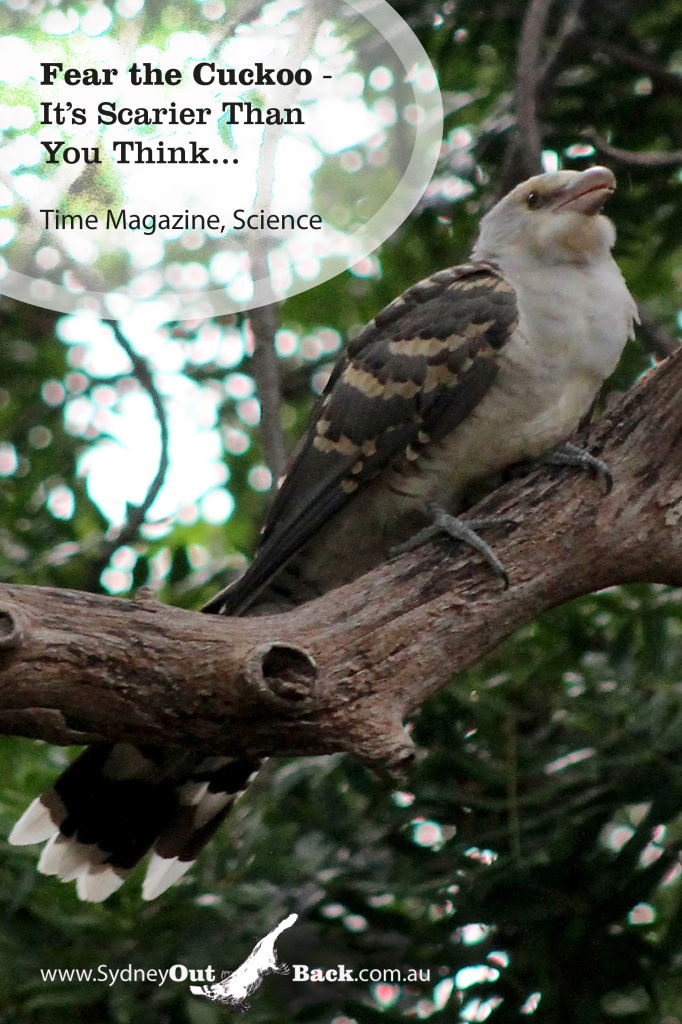 The Channel-billed Cuckoo, sometimes known as the Stormbird, is rarely recognized by locals, despite having one of the most grating, persistent bird calls from late-September to February throughout Ku-ring-gai Chase National Park, and across Sydney’s parks and gardens! This common migratory species has the notoriety of being the world’s largest cuckoo and largest parasitic cuckoo.
The Channel-billed Cuckoo, sometimes known as the Stormbird, is rarely recognized by locals, despite having one of the most grating, persistent bird calls from late-September to February throughout Ku-ring-gai Chase National Park, and across Sydney’s parks and gardens! This common migratory species has the notoriety of being the world’s largest cuckoo and largest parasitic cuckoo.
But nothing is as it seems.
Be warned, once you get to know the Channel-billed Cuckoo, you may not like it very much. Here are four explanations from Sydney OutBack as to why the Cuckoo is considered one of the least likable birds in the region:
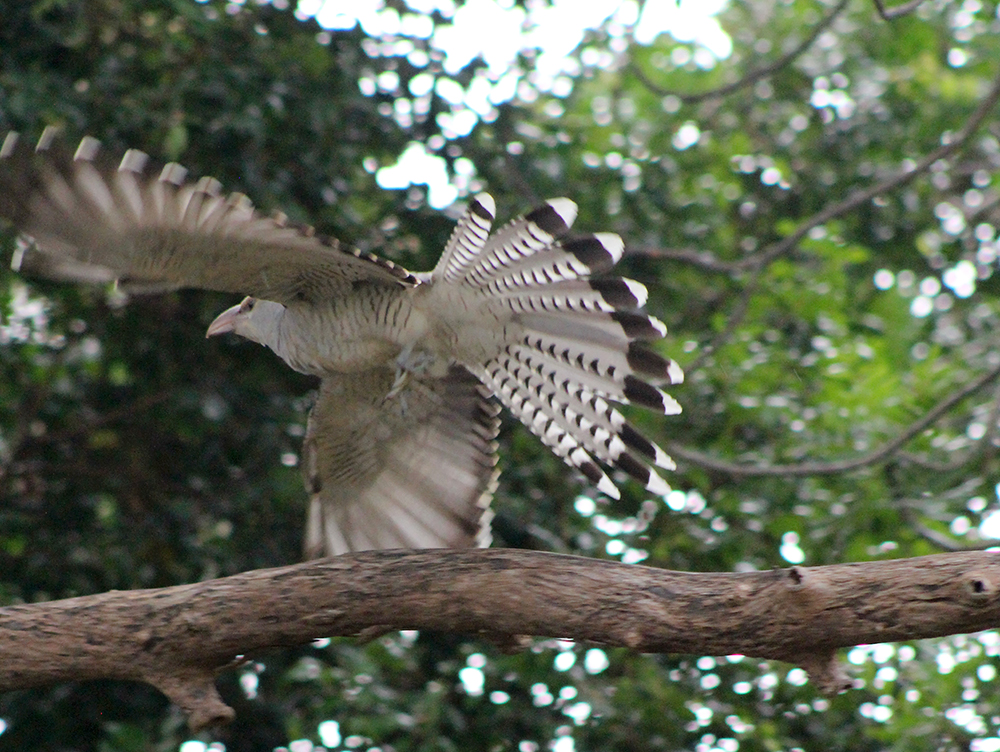 1m. Rude and obnoxious, it exists in its best self-interest only. It doesn’t mate for life, so appears in a solitary fashion trumpeting its arrival for all to hear. Why? Because it is hot-on-the-trot for food and a hot new partner for the breeding season ahead. In doing so, it pollutes the air with an incessant, night-long prehistoric cry of “Gkwark-awk-awk-awk”. Then, like a bad date, the male attracts a female with titbits of food, and he mounts her as she snacks on his gifts. They breed, and then collaborate about what to do next about “the kids”. (When a cuckoo chick is born, the “Gkwark-awk-awk-awk” – translated, “feed me” – is as equally as annoying; but a pitch higher).
1m. Rude and obnoxious, it exists in its best self-interest only. It doesn’t mate for life, so appears in a solitary fashion trumpeting its arrival for all to hear. Why? Because it is hot-on-the-trot for food and a hot new partner for the breeding season ahead. In doing so, it pollutes the air with an incessant, night-long prehistoric cry of “Gkwark-awk-awk-awk”. Then, like a bad date, the male attracts a female with titbits of food, and he mounts her as she snacks on his gifts. They breed, and then collaborate about what to do next about “the kids”. (When a cuckoo chick is born, the “Gkwark-awk-awk-awk” – translated, “feed me” – is as equally as annoying; but a pitch higher).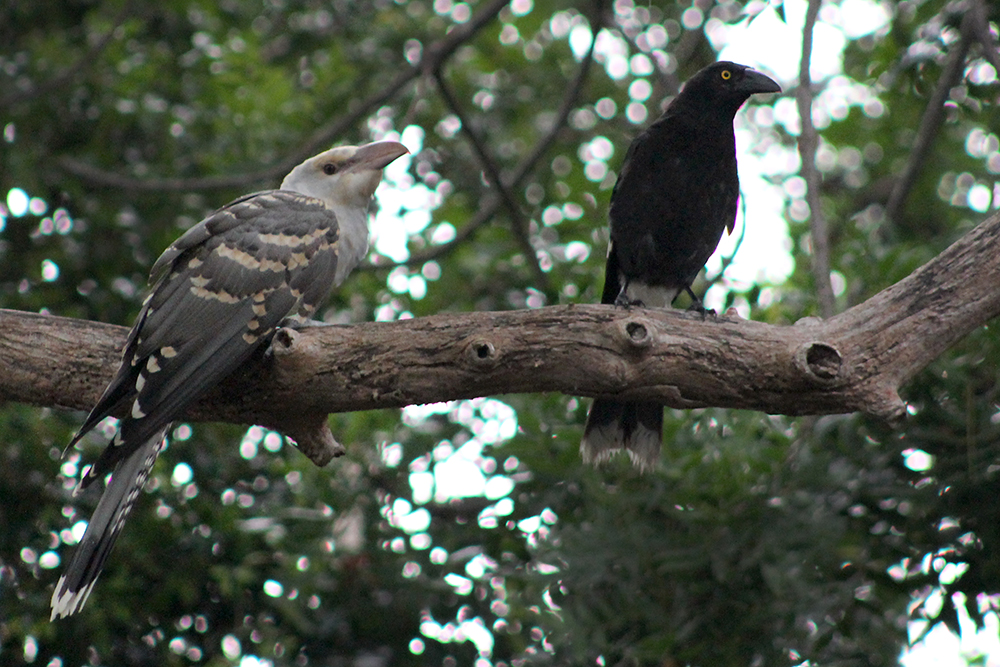 bird is making this annoying call and why is the chick bigger than the parent?” Let us explain: the Channel-billed Cuckoo finds a large native host species – it only breeds to lay eggs if a surrogate host is found. Then the male cuckoo lures the host-bird away – by posing as a predatory threat – as the female cuckoo lays one to two eggs in its nest, often alongside the host’s own eggs. The pair might do this to more than one surrogate host on more than one occasion. Eight native host species are known to be victim to the Channel-billed Cuckoo; but most commonly seen in Sydney OutBack’s experience are the Pied Currawong (Strepera graculina) and, far-second, the Magpie (Gymnorthina tibicen). Conveniently, the cuckoo lays eggs of similar appearance to those in the Pied Currawong or Magpie nest so they blend in (unless the Cuckoo parent cracks the host’s eggs to spoil them). And, unbelievably, a host parent can be subject to not just one “attack” in a season, so may unknowingly be incubating and raising the chicks of more than one Channel-billed Cuckoo pair. The Channel-billed Cuckoo flies off to continue breeding and partying, and having a great time in the Australian summer while someone else is left to all the child-rearing work. All the eggs in the nest are incubated, and hatch. Unlike other cuckoos, these Cuckoo chicks don’t push the hosts’ surviving eggs or chicks from the nest, rather, it monopolises the attention and (because the cuckoo grows faster) it has strength to hog all the food – which is never enough – and other chicks starve to death, despite often putting up a noble fight for life. The unwitting host parent pushes the dead chick/s from the nest, focusing on the stronger one: the Channel-billed Cuckoo.
bird is making this annoying call and why is the chick bigger than the parent?” Let us explain: the Channel-billed Cuckoo finds a large native host species – it only breeds to lay eggs if a surrogate host is found. Then the male cuckoo lures the host-bird away – by posing as a predatory threat – as the female cuckoo lays one to two eggs in its nest, often alongside the host’s own eggs. The pair might do this to more than one surrogate host on more than one occasion. Eight native host species are known to be victim to the Channel-billed Cuckoo; but most commonly seen in Sydney OutBack’s experience are the Pied Currawong (Strepera graculina) and, far-second, the Magpie (Gymnorthina tibicen). Conveniently, the cuckoo lays eggs of similar appearance to those in the Pied Currawong or Magpie nest so they blend in (unless the Cuckoo parent cracks the host’s eggs to spoil them). And, unbelievably, a host parent can be subject to not just one “attack” in a season, so may unknowingly be incubating and raising the chicks of more than one Channel-billed Cuckoo pair. The Channel-billed Cuckoo flies off to continue breeding and partying, and having a great time in the Australian summer while someone else is left to all the child-rearing work. All the eggs in the nest are incubated, and hatch. Unlike other cuckoos, these Cuckoo chicks don’t push the hosts’ surviving eggs or chicks from the nest, rather, it monopolises the attention and (because the cuckoo grows faster) it has strength to hog all the food – which is never enough – and other chicks starve to death, despite often putting up a noble fight for life. The unwitting host parent pushes the dead chick/s from the nest, focusing on the stronger one: the Channel-billed Cuckoo.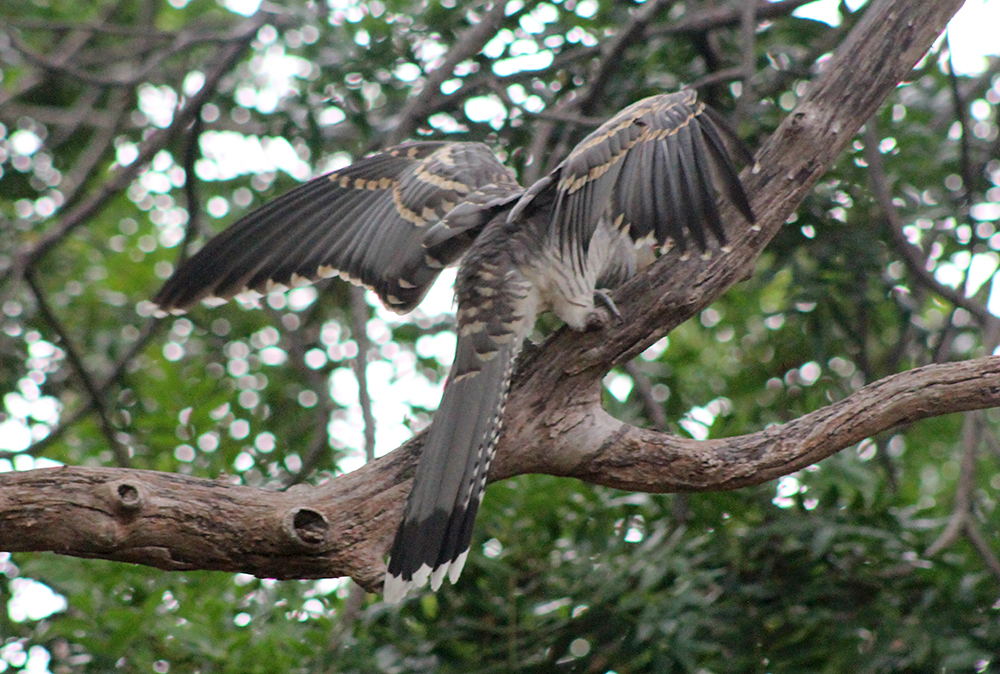
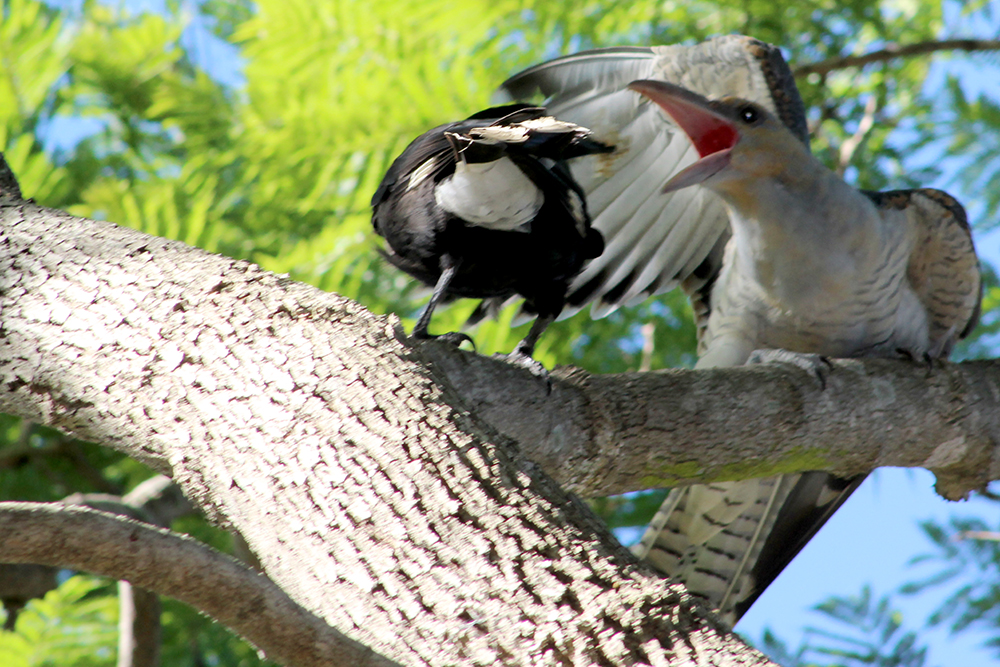 At four weeks, the Channel-billed Cuckoo chick is fully feathered and already as big as (if not bigger than) the host parent. It continues to grow and, as a juvenile, it will be larger than its host “parent”; what an imposing and demanding teenager? It’s persistent and very loud cries for food keep the host on its toes, and, if humans are living nearby and haven’t thrown something in that direction, the cuckoo is served bill and claw with meal after meal from dawn to dusk. And never a thank you.
At four weeks, the Channel-billed Cuckoo chick is fully feathered and already as big as (if not bigger than) the host parent. It continues to grow and, as a juvenile, it will be larger than its host “parent”; what an imposing and demanding teenager? It’s persistent and very loud cries for food keep the host on its toes, and, if humans are living nearby and haven’t thrown something in that direction, the cuckoo is served bill and claw with meal after meal from dawn to dusk. And never a thank you.Surprisingly, there is much unknown about the Channel-billed Cuckoo. Yet, it is still part of the circle-of-life in the Sydney OutBack community and another example of the incredible biodiversity that makes Ku-ring-gai Chase National Park so interesting! To learn more about Sydney OutBack’s Wilderness and Aboriginal Explorer Tour and Cruise, just click here.
Our tours are also part of Tourism Australia’s Indigenous Tourism Champions Program (ITCP), recognizing that we offer a quality experience that that meets the needs and expectations of international visitors.